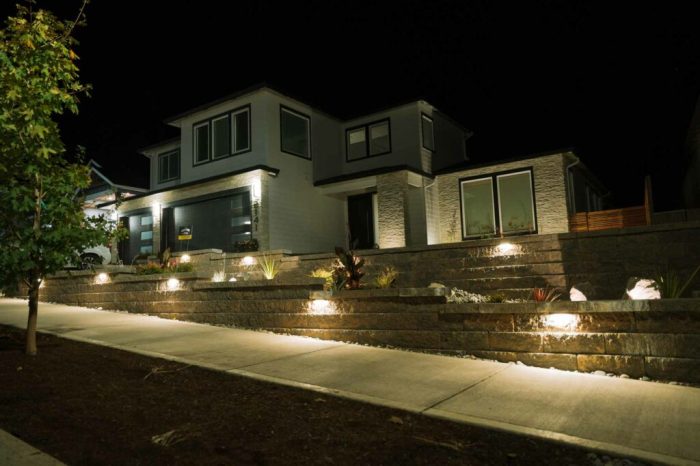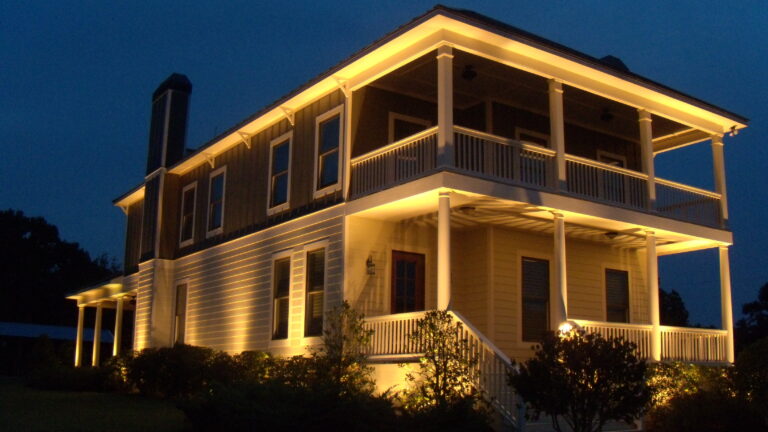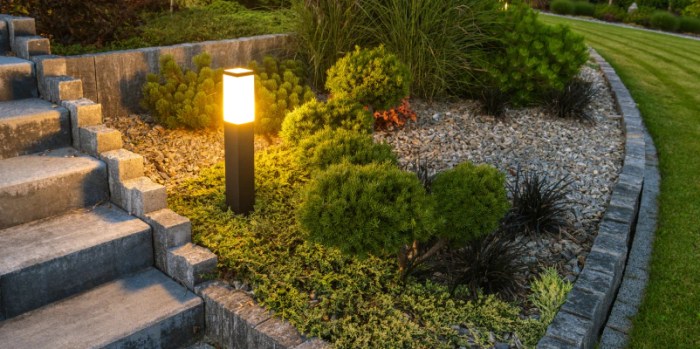Outdoor Lighting Services Near Me Expert Advice
Outdoor lighting services near me are essential for enhancing curb appeal, safety, and enjoyment of your outdoor spaces. This guide explores various lighting options, from the latest LED technology to traditional halogen fixtures. We’ll delve into design considerations for different properties, helping you navigate the process of finding the right lighting solutions for your needs.
We’ll cover everything from understanding the different types of outdoor lighting to choosing a qualified professional and maintaining your system for years to come. From residential pathways to commercial landscapes, this comprehensive resource provides a practical overview of outdoor lighting services and how to find the best options in your area.
Defining Outdoor Lighting Services: Outdoor Lighting Services Near Me
Outdoor lighting services encompass a wide range of applications, transforming outdoor spaces into inviting and functional environments. These services are crucial for safety, security, and aesthetic appeal, extending the usability of outdoor areas beyond daylight hours. Properly designed and installed outdoor lighting enhances the ambiance and value of any property.
Outdoor lighting services involve more than just placing a few lights. A comprehensive approach considers the specific needs of the location, the desired aesthetic, and the overall functionality. This includes careful planning, design, installation, and maintenance to ensure optimal performance and longevity.
Types of Outdoor Lighting Services
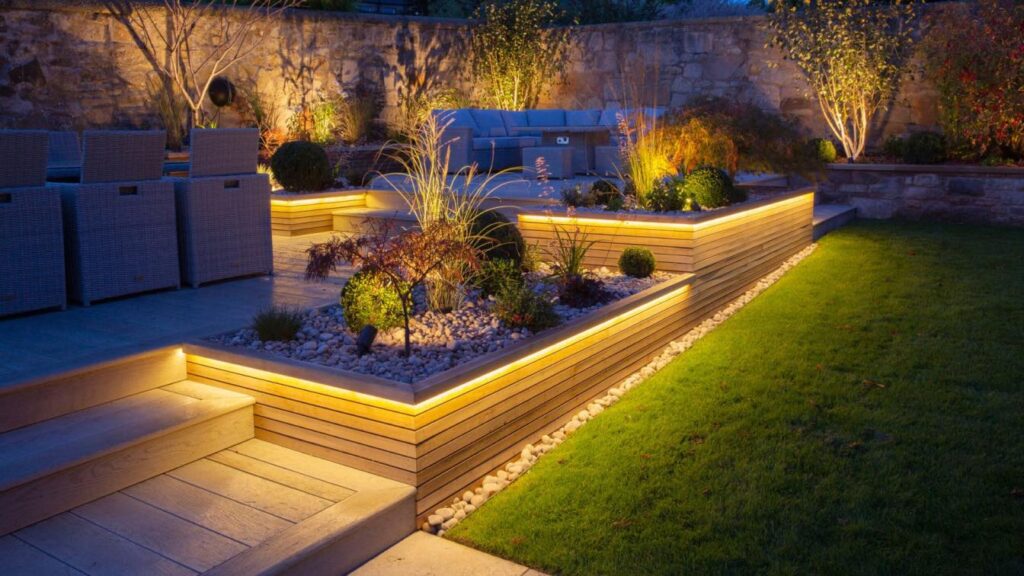
Various outdoor lighting services cater to different needs and preferences. These services include landscape lighting, security lighting, and pathway lighting, each with unique design considerations and installation requirements. Landscape lighting accentuates the beauty of gardens and features, while security lighting provides a deterrent to potential intruders. Pathway lighting guides pedestrians safely through walkways and pathways. Properly chosen and positioned lights can enhance the ambiance of any outdoor area.
Outdoor Lighting Fixtures
Numerous outdoor lighting fixtures are available, each with distinct characteristics and applications. These include spotlights, floodlights, pathway lights, wall-mounted lights, and hanging lights. Spotlights concentrate light on specific objects, enhancing their visibility. Floodlights provide wide-area illumination, suitable for illuminating large areas. Path lights, designed for walkways, emit soft, focused light, ensuring safe navigation. Wall-mounted lights are versatile, adding architectural appeal and functional lighting to walls and structures. Hanging lights provide ambient illumination and can be used in various settings, from patios to gardens.
Lighting Technologies
Several lighting technologies are used in outdoor lighting, each with its advantages and disadvantages. LED (Light Emitting Diode) lights are increasingly popular due to their energy efficiency, long lifespan, and vibrant color options. Halogen lights, while a more traditional choice, are known for their bright, warm light output. Other technologies, such as metal halide and incandescent lights, are also used, but their use is diminishing due to the emergence of more efficient options. Understanding these technologies is essential for selecting the best solution for your specific needs.
Outdoor Lighting Design Styles
Different outdoor lighting design styles reflect diverse aesthetic preferences. Contemporary designs often use minimalist fixtures and subtle lighting to highlight modern architecture and landscaping. Traditional designs emphasize classic fixtures and warm-toned lighting to evoke a timeless ambiance. Transitional designs combine elements of both contemporary and traditional styles to create a balanced and sophisticated look. Consider your home’s architectural style and the desired ambiance when choosing a design.
Comparison of Lighting Technologies
| Technology | Pros | Cons | Cost |
|---|---|---|---|
| LED | High energy efficiency, long lifespan, vibrant color options, low maintenance, and environmentally friendly | It can sometimes have a cooler color temperature compared to halogen, initial cost might be slightly higher. | Medium to high, but long-term cost savings are significant |
| Halogen | Warm, bright light output, relatively affordable initial cost | Lower energy efficiency, shorter lifespan compared to LED, generates more heat | Low to medium |
Service Areas and Geographic Considerations
Outdoor lighting services cater to a diverse range of needs, from illuminating residential landscapes to enhancing commercial spaces. Understanding the specific requirements of different areas is crucial for effective design and implementation. This section explores common service areas and how geographic factors influence outdoor lighting solutions.
Geographic factors play a critical role in outdoor lighting design. Climate, terrain, and local regulations all impact the best lighting choices. For example, harsh winters may necessitate fixtures designed for snow and ice accumulation, while mountainous terrain may require specialized lighting techniques to avoid glare or light pollution. Understanding these factors helps professionals tailor solutions to specific environments.
Common Service Areas
Outdoor lighting services are frequently sought in residential and commercial settings. Residential services often involve illuminating yards, patios, and walkways, aiming for both aesthetic appeal and safety. Commercial applications might focus on enhancing building exteriors, parking lots, or retail displays, often prioritizing security and brand visibility. Industrial settings may require specific lighting solutions for material handling and operational needs.
Geographic Factors in Design
Climate, terrain, and local regulations all play significant roles in the design process. For example, in areas with high humidity, lighting fixtures must be resistant to corrosion. Mountainous regions may need careful consideration of light spill and impact on wildlife. Local ordinances and building codes may specify permitted types of fixtures, light levels, and placement restrictions.
Locating Outdoor Lighting Professionals
Finding reputable outdoor lighting professionals in a specific area involves several steps. Online searches using s like “outdoor lighting services [city/region]” can yield a list of potential providers. Reviewing online reviews and testimonials can offer insights into past performance. Checking professional licensing and certifications can help ensure qualifications. Networking with local businesses and contacting real estate agents may provide recommendations. Also, attending local home improvement or business networking events may lead to opportunities to meet potential providers.
Table of Service Areas and Potential Providers
| Service Area | Potential Providers | Typical Pricing | Regulations |
|---|---|---|---|
| Suburban Residential | Local landscaping companies, specialized outdoor lighting firms, and independent contractors | $500 – $5000+ (depending on project scope and complexity) | Local building codes may dictate fixture types, light levels, and placement. Some areas may have specific restrictions on light pollution. |
| Commercial Properties | Specialized commercial lighting companies, electrical contractors, or firms with expertise in security lighting | $1000 – $100,000+ (depending on building size, features, and lighting needs) | Building codes, security regulations, and zoning laws may influence lighting requirements. Energy efficiency standards may also apply. |
| High-Rise Buildings | Specialized architectural lighting firms, or electrical contractors with experience in high-rise construction | $10,000 – $1,000,000+ (depending on size and complexity) | Stricter regulations on light spill, light pollution, and fixture durability may apply. |
Client Needs and Project Requirements
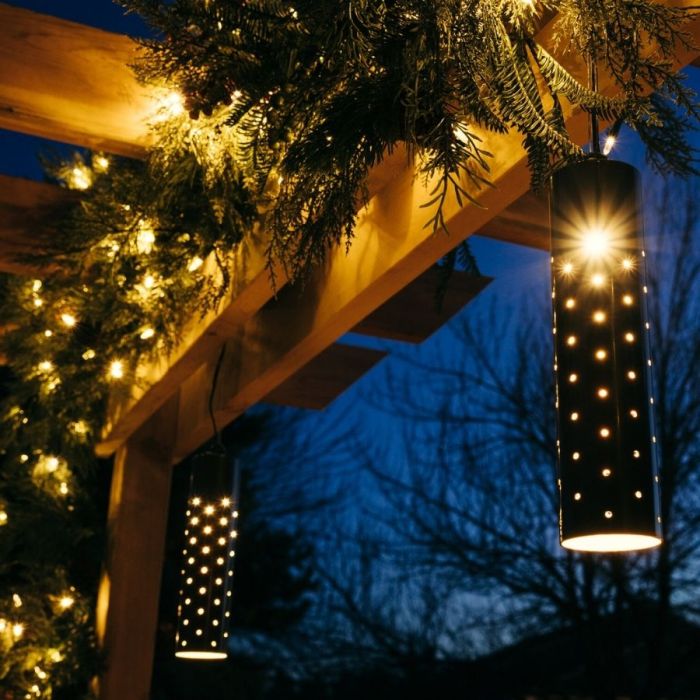
Source: sagelandscapes.com
Understanding client needs is paramount for successful outdoor lighting projects. A thorough assessment of the client’s desires, coupled with careful consideration of the property’s characteristics, is crucial for delivering a customized and effective lighting solution. This section delves into common client needs, design considerations for various property types, and essential questions to gather crucial information.
Common Client Needs for Outdoor Lighting Services
Clients often seek outdoor lighting solutions to enhance safety, security, aesthetics, and enjoyment of their property. Safety is a primary concern, as well-lit pathways and entrances reduce the risk of accidents. Security is another important aspect, as outdoor lighting deters potential intruders. Aesthetics are also vital, with clients often wanting to highlight architectural features, landscaping elements, or create a welcoming ambiance. Finally, many clients desire increased enjoyment of their outdoor spaces by creating areas suitable for evening activities like entertaining, relaxing, or simply appreciating the beauty of their surroundings.
Factors to Consider in Outdoor Lighting Design
The design of outdoor lighting varies significantly depending on the type of property. Residential properties, for instance, typically require lighting focused on pathways, entrances, and landscaping features. The design must balance aesthetics with practicality, ensuring that lights enhance the property’s beauty without being overly intrusive. Business properties, on the other hand, might prioritize security lighting, accentuating architectural details, and illuminating commercial areas like parking lots or retail displays. Consideration should be given to the specific needs and characteristics of each property type.
Questions to Ask Clients
Effective communication with clients is vital for understanding their expectations and preferences. These questions can help illuminate the client’s specific needs and desired outcomes.
- What are your primary goals for outdoor lighting? (e.g., safety, security, aesthetics, entertainment)
- What specific areas of your property require lighting?
- What is your budget for this project?
- Do you have any existing lighting fixtures or plans for them?
- What is your preferred style and aesthetic for the lighting?
- Are there any specific features or areas you would like to highlight with lighting?
- What are your concerns about light pollution or glare?
Common Client Requests for Various Projects
Gathering a comprehensive understanding of client requests for different project types helps in tailoring a suitable lighting plan.
| Project Type | Client Needs | Lighting Design Considerations | Budget |
|---|---|---|---|
| Residential Pathway Lighting | Increased safety and security for navigating walkways, enhancing the beauty of the property at night. Potential desire for soft, ambient lighting to create a welcoming atmosphere. | Placement of fixtures along pathways, consideration of light spill to avoid glare on neighboring properties, and selection of fixtures that complement the home’s architectural style. | Variable, dependent on the length of the pathway and the chosen fixture types. Lower-end fixtures could be under $50 per fixture, with higher-end options exceeding $100 per fixture. |
| Commercial Parking Lot Lighting | Enhanced security and visibility for vehicles and pedestrians. Clients may also require lighting for specific signage or display areas. | Strategic placement of lights to ensure adequate coverage of the entire parking area. Consideration of light color temperature to enhance visibility and safety. High-output fixtures may be required, especially for larger parking lots. | Significantly higher than residential projects, depending on the size and complexity of the lot. Pricing varies based on fixture type, wattage, and installation requirements. |
| Landscape Lighting | Highlighting landscaping features, such as trees, shrubs, and water features, to create a visually appealing display at night. Some clients may want to accentuate specific garden elements. | Careful placement of fixtures to avoid obstructing walkways or interfering with other elements. Consideration of fixture types, colors, and intensities to highlight specific landscape elements effectively. | Dependent on the scope of the landscaping and the complexity of the lighting design. Fixture costs and installation expenses can vary widely. |
Pricing and Budgeting for Outdoor Lighting

Source: wpblandscape.com
Outdoor lighting projects vary significantly in scope and complexity, necessitating a detailed understanding of pricing structures. This section delves into the factors that influence project costs and presents methods for creating realistic budgets.
Pricing outdoor lighting services involves a multifaceted approach, considering the specific needs of each project. From the initial consultation to the final installation, various elements contribute to the overall cost.
Methods of Pricing Outdoor Lighting Services
Different approaches to pricing outdoor lighting services exist. A common method is hourly rates, which are particularly useful for smaller projects or those with unique design elements. Fixed-price contracts are also prevalent, particularly for larger projects with clearly defined scope and deliverables. In this approach, a set amount is agreed upon upfront. A hybrid approach combining aspects of both methods may also be employed for projects with variable components. These different methods allow for flexibility in pricing and budgeting, ensuring a suitable match for the project’s demands.
Factors Influencing Outdoor Lighting Project Costs
Several factors influence the total cost of an outdoor lighting project. The size and complexity of the project play a crucial role, as larger projects with extensive design requirements and multiple fixtures typically command higher prices. The number and type of fixtures, the required labor hours for installation, and the complexity of electrical work all contribute to the final cost. Furthermore, the use of specialized materials, such as high-end fixtures or custom-designed components, can elevate the price. The geographic location and local regulations also factor into the overall cost, as some areas may have specific permitting requirements or higher labor costs.
Sample Project Proposal with Detailed Pricing
| Item | Description | Quantity | Unit Cost | Total Cost |
|---|---|---|---|---|
| Site Survey & Design | Professional assessment of the property and design consultation | 1 | $500 | $500 |
| Fixture Selection & Procurement | Selection of appropriate fixtures and ordering | 10 | $75 | $750 |
| Installation | Labor cost for installation | 40 hours | $50/hour | $2,000 |
| Electrical Work | Wiring and connections | 10 hours | $75/hour | $750 |
| Permitting & Inspection | Obtaining necessary permits and inspections | 1 | $200 | $200 |
| Contingency | Allowance for unforeseen expenses | 1 | $250 | $250 |
| Total | $4,450 |
Methods of Budgeting for Outdoor Lighting Projects
A critical aspect of outdoor lighting projects is effective budgeting. A comprehensive budget considers all potential expenses, including materials, labor, permits, and contingencies. Detailed cost breakdowns for each project phase provide transparency and enable informed decision-making. Furthermore, incorporating contingency funds allows for adjustments and unexpected costs.
- Detailed Cost Breakdown: A detailed breakdown of costs, including materials, labor, permitting fees, and potential unforeseen expenses, provides a clear picture of the project’s financial implications. This breakdown should include specific details about each item to enhance transparency and accountability.
- Contingency Planning: Allocating a contingency fund for unforeseen circumstances, such as material price fluctuations or unexpected delays, is crucial for project success. Contingency planning mitigates the risk of budget overruns and ensures financial stability throughout the project.
- Phased Budgeting: Dividing the project into manageable phases allows for more precise budgeting and tracking of expenses. This approach helps maintain control over costs and ensures efficient project management. It also enables more predictable expenditures, enabling better planning.
Finding and Choosing Local Providers
Selecting the right outdoor lighting provider is crucial for a successful project. A qualified professional can ensure that the design, installation, and maintenance of your lighting system meet your needs and budget. Careful consideration and due diligence will lead to a well-executed project that enhances your property’s aesthetic appeal and safety.
Identifying Qualified Professionals
Finding a qualified outdoor lighting professional involves a multi-faceted approach. Begin by researching local businesses specializing in outdoor lighting. Look for companies with a proven track record, positive online reviews, and experience in handling projects similar to yours. A reputable company will have a clear understanding of local regulations and ordinances concerning outdoor lighting.
Factors to Consider When Choosing a Provider
Several key factors influence the selection of a reliable provider. Reputation plays a vital role, as word-of-mouth referrals and testimonials offer valuable insights into a company’s past performance. Experience matters; a provider with extensive experience in similar projects demonstrates proficiency and expertise. Positive customer reviews from previous projects can provide an understanding of the company’s service quality. Finally, consider guarantees or warranties offered by the provider. These assurances can protect your investment and ensure satisfactory service.
Evaluating Multiple Quotes, Outdoor lighting services near me
Obtaining multiple quotes is essential for informed decision-making. This process allows you to compare pricing, service offerings, and project timelines from different providers. Comparing the quotes should include a thorough analysis of each provider’s approach, the proposed scope of work, and any potential hidden costs. This proactive approach ensures you get the best value for your investment.
Checklist for Evaluating Potential Providers
A comprehensive checklist streamlines the evaluation process. Consider the following points when assessing potential providers:
- Company Background and Experience: Review the provider’s website for information on their history, experience in outdoor lighting projects, and team members’ qualifications. Look for details about certifications, licenses, and relevant affiliations. Check for their insurance coverage to mitigate risks.
- Project Portfolio: Examine the provider’s project portfolio to assess their design aesthetic and installation capabilities. Visual examples of past projects can help you determine their expertise and aesthetic preferences.
- Pricing and Payment Terms: Carefully compare pricing structures, including material costs, labor rates, and any additional fees. Understand the payment schedule and ensure it aligns with your budget and financial capabilities. Ask about potential financing options if needed.
- Communication and Responsiveness: Evaluate the provider’s communication style and responsiveness. Schedule a consultation to assess their communication and promptness in answering your questions.
- Customer Testimonials and Reviews: Examine online reviews and testimonials from previous clients. Seek recommendations from trusted sources for firsthand insights into their service quality and responsiveness.
Maintenance and Long-Term Care
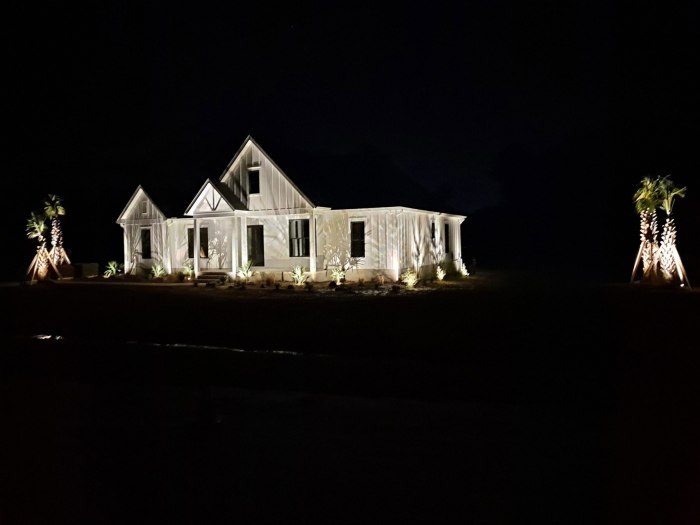
Source: carolinacoastalgardens.com
Proper maintenance is crucial for the longevity and optimal performance of any outdoor lighting system. Regular upkeep not only extends the lifespan of the fixtures but also ensures safety and efficiency, minimizing potential issues and costly repairs down the road. This proactive approach safeguards your investment and enhances the aesthetic appeal of your outdoor space.
Importance of Regular Maintenance
Regular maintenance tasks prevent small problems from escalating into larger, more expensive issues. This proactive approach reduces the risk of unexpected outages, ensures consistent illumination, and safeguards the system from damage due to environmental factors. By addressing minor problems promptly, you avoid costly replacements and maintain the system’s overall performance. For example, a simple cleaning of the fixtures can prevent corrosion and extend the lifespan of the light bulbs.
Maintenance Procedures for Different Lighting Types
Various outdoor lighting systems require specific maintenance procedures. Understanding these differences is key to ensuring effective upkeep.
- LED Lighting: LEDs typically require minimal maintenance. Cleaning the fixtures periodically is sufficient. Regular checks for loose connections or damaged components are essential.
- Halogen Lighting: Halogen fixtures often need more frequent cleaning to prevent dust accumulation, which can affect bulb performance. Regular checks for damaged components and loose connections are critical. Inspect the bulbs for signs of burning or blackening.
- Metal Halide Lighting: Metal halide fixtures, due to their higher heat output, require more frequent checks for overheating. Cleaning the fixtures and inspecting the ballasts are crucial for optimal performance.
Warranties and Service Contracts
Warranties and service contracts offer valuable protection and peace of mind. They provide a structured approach to addressing potential issues and ensure that your system is properly maintained throughout its lifespan. They typically cover repairs or replacements due to manufacturer defects. A service contract may include preventative maintenance visits, providing a more comprehensive solution. A service contract can be an invaluable tool for avoiding costly repairs or unexpected downtime.
Prolonging the Lifespan of Outdoor Lighting Systems
Several strategies can contribute to a longer lifespan for outdoor lighting systems.
- Regular Inspections: Routine inspections identify potential problems early on, preventing larger issues from arising. This includes checking for loose connections, damaged components, or signs of wear and tear.
- Environmental Protection: Protecting fixtures from harsh weather conditions, such as rain, snow, or extreme temperatures, is crucial. Ensuring the proper sealing of fixtures is critical.
- Proper Installation: A correctly installed system is critical to its long-term performance. Employing qualified professionals for installation minimizes future maintenance needs and ensures proper grounding.
- Choosing High-Quality Components: High-quality components, such as durable fixtures and long-lasting bulbs, contribute to a longer lifespan of the system. This investment can lead to substantial savings in the long run.
Final Conclusion
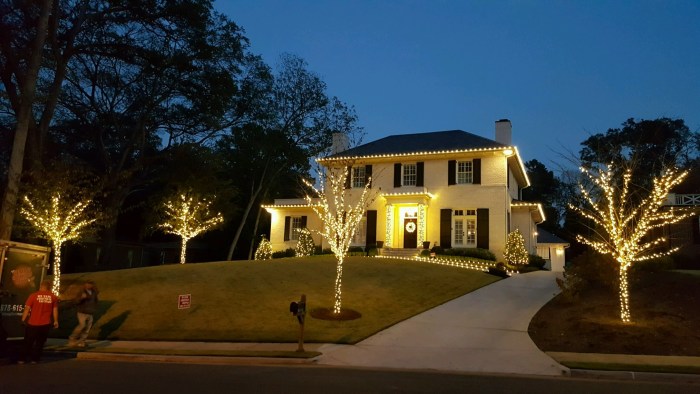
Source: lightsallyear.com
In conclusion, finding the right outdoor lighting services near you involves careful consideration of your needs, budget, and desired aesthetic. By understanding the various lighting technologies, service areas, and client requirements, you can confidently navigate the process and achieve a beautifully illuminated and functional outdoor environment. Remember to prioritize professional consultation and ongoing maintenance to maximize the lifespan and value of your outdoor lighting system.


